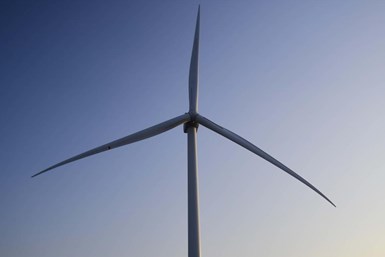Utility-scale offshore wind installation Vineyard Wind orders Haliade-X turbines
GE Renewable Energy will be supplying 62 units of the Haliade-X 13 MW turbine for the Vineyard Wind 1 installation in Massachusetts, with energy generation expected to start in 2023.

Haliade-X wind turbine. Photo Credit: GE Renewable Energy
GE Renewable Energy (Paris, France) has received an order from Vineyard Wind (New Bedford, Mass., U.S.) to supply Haliade-X turbines — which use GE’s 107-meter-long wind blades — for Vineyard Wind 1, said to be the first utility-scale offshore wind installation in the U.S. The project will be installed 15 miles off the coast of Martha’s Vineyard in Massachusetts and will feature 62 units of the Haliade-X 13 MW turbine. With energy generation expected to start in 2023, the project is said to provide cost-competitive electricity for more than 400,000 homes and businesses in the area and reduce carbon emissions by more than 1.6 million tons per year.
GE was selected as the preferred turbine supplier for the project in December 2020. Vineyard Wind 1 recently became the first offshore wind farm in the U.S. to achieve a financial close, which enabled Vineyard Wind and GE to achieve this latest contractual milestone.
According to GE, the Haliade-X was initially designed to produce 12 megawatts (MW) — and even at that level, a single rotation of the machine’s blades could generate enough power to supply the equivalent of one U.K. household for two days. However, after testing its prototype in Rotterdam in 2019, the company began successfully operating its prototype at 14 MW last month. “When we first commissioned our Haliade-X prototype in November 2019 at 12 MW, we made a big leap forward in the industry,” says Vincent Schellings, chief technology officer at GE Renewable Energy. “Over the past two years we have learned a lot about operating and optimizing the performance of our Haliade-X platform, enabling us to uprate the Haliade-X platform to 14 MW today.”
Those incremental improvements add up to produce real environmental benefits, says GE. One of the 14-MW machines “can generate up to 74 gigawatt-hours of gross annual energy production, saving up to 52,000 metric tons of CO2, which is the equivalent of the emissions generated by 11,000 vehicles [according to the EPA Greenhouse Gas Equivalencies calculator] in one year.”
Related Content
-
Materials & Processes: Resin matrices for composites
The matrix binds the fiber reinforcement, gives the composite component its shape and determines its surface quality. A composite matrix may be a polymer, ceramic, metal or carbon. Here’s a guide to selection.
-
Plant tour: ÉireComposites, Galway, Ireland
An in-house testing business and R&D focus has led to innovative materials use and projects in a range of markets, from civil aerospace to renewable energy to marine.
-
Moving toward next-generation wind blade recycling
Suppliers, fabricators and OEMs across the composite wind blade supply chain ramp up existing technologies, develop better reclamation methods and design more recyclable wind blades.













